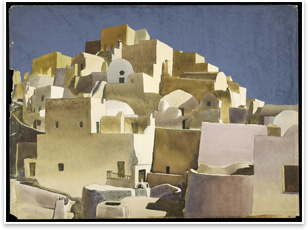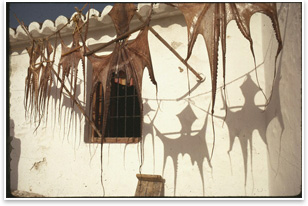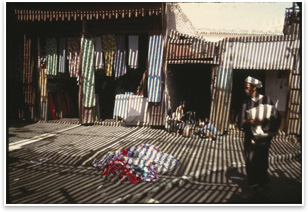SUSTAINABILITY
Sustainability by ‘Amateurs’
by Michael J. Crosbie, PhD, AIA
Contributing Editor
 Summary: A new exhibit on “Lessons from Bernard Rodofsky” just opened at the Getty Research Institute in Los Angeles, and Rodofsky’s insights about the role of sustainability are timely for architects today. Rodofsky, who died 20 years ago, was an architect, exhibit and fashion designer, curator, and critic who opened the design world’s eyes to the genius of vernacular architecture with his exhibit, “Architecture Without Architects” at New York’s Museum of Modern Art in 1964. Summary: A new exhibit on “Lessons from Bernard Rodofsky” just opened at the Getty Research Institute in Los Angeles, and Rodofsky’s insights about the role of sustainability are timely for architects today. Rodofsky, who died 20 years ago, was an architect, exhibit and fashion designer, curator, and critic who opened the design world’s eyes to the genius of vernacular architecture with his exhibit, “Architecture Without Architects” at New York’s Museum of Modern Art in 1964.
The book by the same name that accompanied the MoMA exhibit should be a staple of every architect’s library. Through compelling photographs and insightful (and gently pointed) commentary, Rodofsky takes us on a tour of buildings, towns, and landscapes designed by those uneducated in architecture, but whose native intelligence leaps off the page: hilltowns in Italy and Greece, an underground village in northern China, Dogon cliff dwellings, a city in Morocco made up of thousands of courtyard houses, arcades in western Spain, a grass courthouse in the Solomon Islands.
 In his text, Rodofsky observes that “First World” city dwellers often flee to these places on their vacations, looking for an authentic if quaint environment, at least for a week or two. But when we review today the images of environments that Rudofsky collected some 45 years ago, we are struck by how efficient, sustainable, environmentally tuned, recycled, and recyclable these creations are. They put our so-called sophisticated, LEED®-plated buildings to shame. In his text, Rodofsky observes that “First World” city dwellers often flee to these places on their vacations, looking for an authentic if quaint environment, at least for a week or two. But when we review today the images of environments that Rudofsky collected some 45 years ago, we are struck by how efficient, sustainable, environmentally tuned, recycled, and recyclable these creations are. They put our so-called sophisticated, LEED®-plated buildings to shame.
I know what you’re thinking: well, it’s easy to be green in a low-energy culture that doesn’t demand high-tech, functional environments that have to be mechanically heated and cooled and monitored and ventilated. But even in our energy-driven, high-performance world, Rodofsky’s collection of architecture without architects has a lot to teach us about building in rhythm with the Earth.
 There are several lessons: There are several lessons:
- Design and build with local stuff. I don’t think there is a building in Rodofsky’s book made of materials that were carted more than a few miles to the construction site. What are the options of doing the same thing on your next project? Our material palettes are much richer, yet there are still lots of choices that can be acquired locally. Building with local materials also helps the local economy, which strengthens the economic sustainability of the region.
- Use thermal mass. Many of the buildings in Architecture Without Architects are in warm climates and made of substantial materials (stone, brick, mud, tile, or carved into the earth itself) that naturally help to slow the temperature swings within the building. This is a viable lesson and it can help architects in shaping and massing the building for sculptural effect: art from environmental science.
- Catch the wind. If you are designing in a temperate climate, you may be able to rely less on mechanical cooling and ventilation and shape your building to catch prevailing breezes that will cool and ventilate without expending energy to do so. Again, architectural expression dovetails with this approach. Rudofsky shows us the roofscapes of the lower Sind district in Western Pakistan, animated with windscoops (one for each room) that channel the breeze and bring it deep into the building.
- Follow the sun. Look at the native architecture that Rudofsky collected and you can always tell where the sun is—its track in the sky, and how the building bends and opens to gather it, but also how it huddles and turns to provide shelter from it. Courtyards, porches, balconies, and arcades open and close, like the aperture of a camera, in response to how the sun moves around the building. These buildings never forget their place on the earth, and respond accordingly.
- Reuse, recycle, renew. Nonarchitects never seem to have a problem with pulling materials together from different resources (often, old buildings!) to make a new environment. The amount of wasted building materials in our own culture is staggering. Look into the possibilities of recycling part of a client’s existing building into a new one, turn old materials over to recycling centers, and work with manufacturers who have a recycling program for their products.
 “There is much to learn from architecture before it became an expert’s art,” wrote Rodofsky. These untutored designers “display an admirable talent for fitting their buildings into the natural surroundings,” where they “welcome the vagaries of climate and topography.” “There is much to learn from architecture before it became an expert’s art,” wrote Rodofsky. These untutored designers “display an admirable talent for fitting their buildings into the natural surroundings,” where they “welcome the vagaries of climate and topography.”
Not bad for amateurs. |





